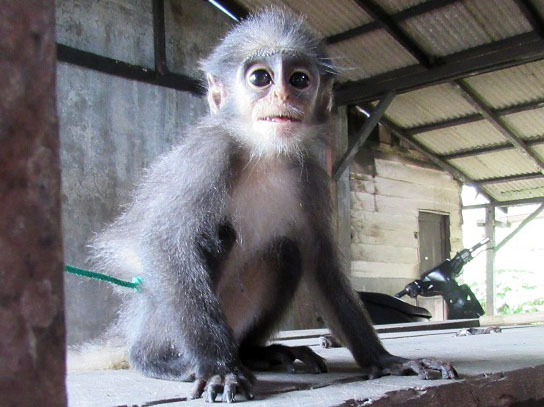Posted on 22:12 April 24th, 2017
The Indonesian Species Conservation Programme (ISCP) and the
Scorpion Foundation carried out an outreach activity in Salabulan and Buluhawar
villages of Sibolangit sub-district in North Sumatra. As the result from the
activity, a villager, Mr. Iyus Tarigan handed over his animal, a Silvered leaf
monkey (Trachypithecus cristatus) to the
outreach team who later delivered the animal to the Wildlife Authority (BBKSDA)
in North Sumatra province.
A Wildlife Authority in Sibolangit, Mr. Samuel told Scorpion Sunday (23rd of
April 2017) that this silvered leaf monkey would be released back in the wild
habitat on the 29th of April 20117. The release will be integrated with the
celebration of Earth Day this year.
According to Samuel, this animal was kept by the villager
for only a couple days, therefore, it was still wild.
Hand over of the silvered lead monkey from the villager
to the outreach team took place on Friday (21st of April 2017) and handed over
to the Wildlife Authority on the same day.
The
www.inaturalist.org describes that the
Silvered leaf monkey, also called Lutung leaf monkey, is a medium-sized monkey with a long,
non-prehensile tail. It has grey-tipped, dark brown or black fur, giving it a
uniform silvery appearance. Unlike some related species, there are no paler
markings on the face or body, except for a patch of whitish hair on the groin
of females. A crest of fur runs along the top of the head, and the hair on the
cheeks is long, often obscuring the ears. The hands and feet are hairless, with
dark coloured skin, and have opposable thumbs and toes.
Females range from 46 to 51 centimetres (18 to 20 in) in
head-body length, with an average weight of 5.7 kilograms (13 lb) and a tail
length of 67 to 75 centimetres (26 to 30 in). Males are slightly larger, from
50 to 58 centimetres (20 to 23 in) in length, with an average weight of 6.6
kilograms (15 lb) and a tail length of 67 to 75 centimetres (26 to 30 in).
Like other langurs, the silvery lutung has a large
three-chambered stomach to digest the cellulose found in its herbivorous diet.
This allows for fermentation of food, and has some similarities with the
stomach of ruminants. The intestine is unusually long, even compared to those
of other langurs, and has a number of pouches along its length, which carry out
further fermentation of plant matter. The teeth have grinding ridges and other
modifications to allow the more efficient processing of tough leaves.
Latest info: release of this monkey has been postponed for further medical care.



Photo: SCORPION



